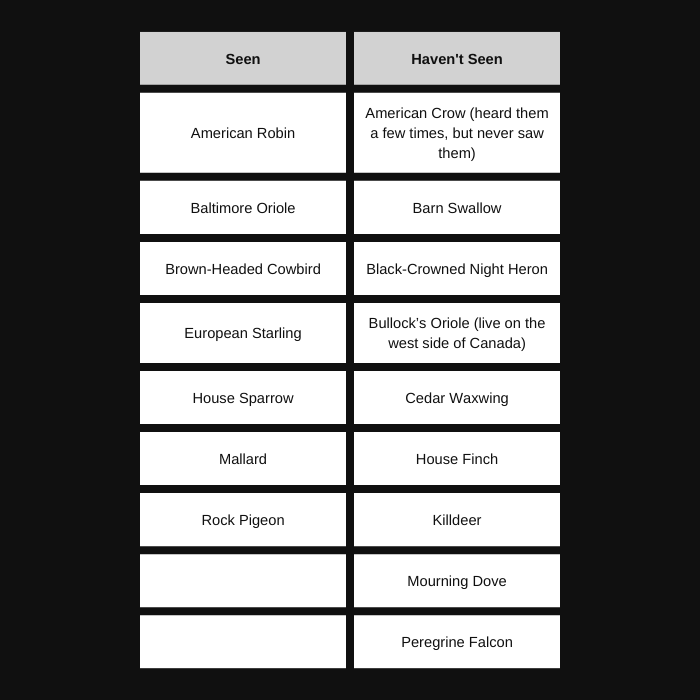XX. Summary + Sources
After going to all of the parks, it is already solid that most birds would not want to live in urban areas. Based on my records, the most popular birds that I’ve seen were the American Robins (40 times), House Sparrows (38 times), and European Starlings (33 times). I found it a bit surprising that I didn’t see many Rock Pigeons. I would generally see them almost every time I go out (in urban areas of course) so maybe the parks aren’t exactly for them. In conclusion, here are the focal species I’ve seen verses haven't seen:

On the other hand, it is also true that going to green places makes me happier. Not only does my serotonin increase each time I go to a park, but I’m also highly motivated, active, and energetic for the rest of the day. On the days that I stayed home, I usually end up being lazier and procrastinate on my work much more.
There are also numerous experiences that I’ve learned throughout this project too! To keep it short and simple, here are a few things I’ve noticed:
- The locations of the parks really matter for living beings as I said above. Fountainhead Park is near a more urban setting where there are buildings and roads next to it. Even though it had a lot of grass and a decent amount of trees, the diversity of birds was really little and only consisted of three bird species. All the other parks I've gone to had a larger diversity of birds as it was near forests, lakes, or other ecosystems that are suitable for animal habitats.
- Weather also matters in bird watching. During the first week, I went to Fred Young Park on a cloudy day and barely saw any birds. I tested this again during the second week in Dan Iannuzzi and noticed most birds appear more during the sunnier days. Even though the cloudy days didn't consist of rain, they don't seem to come out much at all.
- This is more bird-related, but during the fifth week in Derrydowns Park, I saw two Northern Flickers for the first time. I didn't know they were woodpeckers since they look much larger in size and were looking for food in the ground. After doing some research, I learned that the only difference between these birds from other woodpeckers is that they usually prefer to eat insects and berries from the ground over trees and found that really cool.
- I have mentioned how the parks from weeks 4 to 6 are all connected, but the birds that live there are really different. Even though the parks are similar by appearance, I feel like the most possible reason would be based on local adaptation where a population of species chooses to be suited in a local environment in comparison to the other same species that would rather live elsewhere.
So speaking of my volunteering experience, would I do a citizen science project again? I would definitely say yes because there are a lot of new things that you get to learn from doing projects like this. Even though I’ve always been a nature lover, I never thought about how much people have underestimated biodiversity in depth until I got to see it with my own eyes. However, I would rather do another one over the summer as it may seem time-consuming to do it during the school year. Here are a few projects that I have in mind:
- eButterfly: reporting butterfly sightings
- Deep Sea Explorers: studying bio-activity in the deep sea
- Penguin Watch: counting penguins, chicks and eggs in far away lands
To end off, I want to give a huge thank you to Professor Marushia and anyone else who’s responsible for NATS 1940 for providing students with an opportunity on doing a citizen science project. This project has helped me learn a lot especially from a hands-on experience, and I would highly recommend future students to take this course to understand the importance of biodiversity.
---
All Sources Used:
bce_admin_user. (n.d.). Cornell Lab of Ornithology-Home. Birds, Cornell Lab of Ornithology. Retrieved July 17, 2022, from https://www.birds.cornell.edu/home/
Celebrate urban birds. Celebrate Urban Birds. (n.d.). Retrieved July 11, 2022, from https://celebrateurbanbirds.org/
Major threats to birds in Canada. (n.d.). Retrieved July 8, 2022, from
https://www.birdscanada.org/conserve-birds/major-threats-to-birds/
What time of the day do birds eat? Bird Fact. (n.d.). Retrieved July 17, 2022, from https://birdfact.com/articles/what-time-do-birds-eat
Isaksson, C. (1970, January 1). Impact of urbanization on birds. SpringerLink. Retrieved July 25, 2022, from https://link.springer.com/chapter/10.1007/978-3-319-91689-7_13#:~:text=The%20city%20attracts%20many%20birds,nonurban%20habitats%20
Ebutterfly. SciStarter. (2021, May 24). Retrieved July 21, 2022, from https://scistarter.org/ebutterfly
Zooniverse. zooniverse.org. (n.d.). Retrieved July 21, 2022, from https://www.zooniverse.org/projects/reinforce/deep-sea-explorers
Zooniverse. zooniverse.org. (n.d.). Retrieved July 21, 2022, from https://www.zooniverse.org/projects/penguintom79/penguin-watch